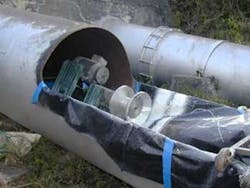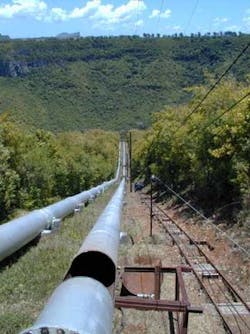By John Cant
Renovating pipelines in Mauritius' remote mountain area cost only 4% of the estimated replacement cost and improved hydropower generation efficiency.
The Mauritius Central Electricity Board reports that hydroelectric power generation at the Tama-rind Falls plant improved due to a pipeline renovation project that signi-ficantly reduced energy losses in two pipelines. Completed last January 2002, the project took only nine weeks and cost approximately £200,000 (US$ 312,000), less than 4% of the replacement estimate.
Tamarind Falls is one of four hydroelectric plants serving the Indian Ocean island and is fed by twin 850-mm steel pipelines, each 800-m-long. The operating company, the Mauritius Central Electricity Board, was concerned about the condition of the 50-year-old pipelines because they were corroding externally and similar pipelines were known to be corroding internally.
The company sought the advice of the WRc, an international water and environmental consultancy from the United Kingdom, which carried out a condition survey. This investigation revealed severe internal corrosion and only six years of useful life remaining. An early solution was needed to avoid pipeline failure and power loss.
The two options were replacement or refurbishment but the location made replacement difficult and costly. The feed water pound is located in the mountains some 285m higher than the turbines, and the pipes run down the side of the mountain at a gradient of up to 1 in 1.4. The only access is by a cable railway, which runs to the mountaintop and is suitable for the light loads of a rehabilitation project.
Experts from WRc Rehabilitation Division examined the pipes and concluded it was possible to fully renovate them, despite the high operating pressure of over 30 bar and surface temperatures in excess of 40°C. The method chosen was to clean the pipelines internally and then apply a resin lining.
WRc designed and supervised the operation, which was carried out by a South African specialist company, John Davies Pipeline Services CC. One of the main technical difficulties was preparing the corroded pipe internally to obtain a satisfactorily clean surface on which the resin would bond. The large pipe diameter and high operating pressures require a good bond.
The technicians cut openings in the pipes to insert the specialist lining equipment. The internal surfaces were first cleaned using automated grit-blasting equipment to obtain the high quality finish needed for successful reinstatement, and then the pipelines were given a final wash to remove debris.
The epoxy-resin lining Magnaline, manufactured by Chemrite Coatings of South Africa, met the necessary performance requirements for a high thickness (1 mm), highly durable coating that would not cause any water contamination but would achieve the necessary high strength bond to the steel surface.
The new lining was applied in a single pass using a specially built manually operated epoxy spray rig designed for large man-entry-size pipelines. A one-pass continuous application is essential to achieve the quality standards needed to extend service life by at least 50 years.
According to Paul Conroy of WRc , "WRc dealt with every stage of the Mauritius project, and a clinical attention to detail identified a solution that combined least cost and least disruption with a massive increase in service life."
Author's note
John Cant is a consultant engineer for WRc, an international water and environment consultancy, located in Swindon, Wiltshire, England.





